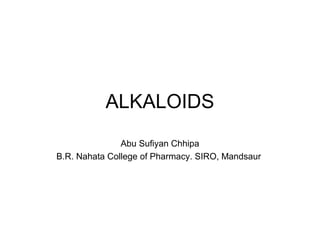Alkaloids
- 1. ALKALOIDS Abu Sufiyan Chhipa B.R. Nahata College of Pharmacy. SIRO, Mandsaur
- 2. Alkaloids •The alkaloids are defined as ‘basic nitrogenous plant products, mostly optically active and possessing nitrogen heterocyclic as their structural unit, with a pronounced physiological action. •The term alkaloid was coined by W. Meissner, a Germon Pharmacist. The first alkaloid to be synthesised was Coniine in1886.It was isolated in 1827. •These are organic product of natural and synthetic origin which are basic in nature and contain one or more nitrogen atom, normally of heterocyclic nature and posses specific pharmacological action on human or animal body. •The true alkaloids are toxic in nature.contain hetrocyclic nitrogen which is derided from amino acids and always basic in nature. A.Protoalkaloids:simple amine, nitrogen is absent in ring/biological amines.ex Mescaline, ephedrine , colchicine B.Pseudoalkaloids :includes steroids and terpenoids alkaloids, not derived from amino acids. They donot shows typical charaters of alkaloids by give posative test for alkaloids.
- 3. Physical Properties • Colorless, crystalline solids • Sharp melting points • Some are amorphous gum • Some are colored Betanidin is red, Berberine is yellow • Soluble in organic nonpolor solvents, immiscible solvents • Salt are soluble in water. • Chemical nature: Basic in nature due to presence of nitrogen or avilability of lone pair of electron on N.
- 6. • Alkaloids • All the extracts were evaporated separately then the acidic solution of extracts was prepared by dissolving it in hydrochloric acid & was then filtered. These extract solutions were then used for different tests which are as follows: • a) Dragendorff’s test- 2-3ml of extract solution + few drops of Dragendorff’s reagent (positive test shows orange brown colored precipitate) • b) Mayer’s test- 2-3ml of extract solution + few drops of Mayer’s reagent (positive test shows cream colored precipitate) • c) Hager’s test- 2-3ml of extract solution + few drops of Hager’s reagent (positive test shows yellow colored precipitate) • d) Wagner’s test- 2-3ml of extract solution + few drops of Wagner’s reagent (positive test shows reddish brown colored precipitate)
- 7. Classification of alkaloids on the basis of their chemical nature is as follows: • Phenylalkaylamine ( Epherine, Pseudoephedrine, Taxine, Hordenine) • Pyrrolidines, Piperidines andpyridines • Tropane alkaloids (Hyoscamine, atropine and hyscine) • Quinoline alkaloids of Cinchona • Indole alkaloids (Apocyanaceae, Rubiaceae and Loganiaceae) • Purine alkaloids (Caffeine, Threobromine, methylated derivatives of Xanthine) • Tropolone alkaids (Colchicines) • Isoprenoid alkaloids • Diterpenoid alkaloids
- 8. • In the recent past, the alkaloids have been divided into two major categories based on the analogy that one containing a non-heterocyclic nucleus, while the other having theheterocyclic nucleus. These two classes of alkaloids shall be discussed briefly as under. • (a) Non-heterocyclic Alkaloids A few typical alkaloids having non-heterocyclic nucleus are erumerated below: •
- 9. Heterocyclic Alkaloids A large number of specific alkaloids possessing heterocyclic nucleus are stated below:
- 12. Atropine • Obtained from Atropa bellodona, Datura stramonium, D. metal. • Generally it is obtained from l-hyosyamine. • Optically inactive • Atropine is racemic mixture of Hyosyamine. • Molecular formula . • C17H23NO3 • It is mixture of Tropic acid and Tropine.
- 15. Pharmacological action • CVS: cause Tachycardia due to blockge of vaginal impulse to the SA Node, donot have any marked effect on B.P. • Eyes: cause Mydriasis, blurring of vission, intraoccular tention increase. • Smooth Muscles: relaxed intestinal and stomach muscles, also relaxed uterine muscles. Produce bronchodilation. • Glands: Decrease sweat, salivary lachrymal secretion. • Body Temp: Increases at high dose due to inhibition of sweating and stimulation of temp regulating centers.
- 16. Therapeutic Uses • Stimulate vagal vasomotor, respiratory center. Used in CNS disorders. • Scopolamine and Atropine is effective in treatment of nausea and vomiting or motion scikness. • Due to their anticholinergic action used in Parkisonium disease. • Antispasmodic: relax the smooth muscles of intestine, urinary bilary tract. • Antisecretory activity: reduce gastric secretion in peptic ulcer. • Used as Preanesthetic medication.
- 17. Reserpine • Obtained from Rauwlfia serpentina. • Methyl ester of Pentacyclic reserpic acid and is linked through –OH group at position 18 by ester linkage through Trimethoxy Benzoic acid.
- 19. Mode of action • It produce hypotension due to depression of hypothalamus and induce peripheral depletion of Catecholamine. • Reserpine interfere synthesis of noradrenaline because it block the uptake of dopamine into the vesicle and this release stored noradrenaline.
- 20. Therapeutic Uses • In Psychotic disorders • Anxiety, Tention • Aggressiveness • In hypertension, it lower the systolic and diostolic B.P. and cause Bradycardia.
- 21. Ephedrine • Obtained from stem of Ephedra geradiana, • Fam: Gentiaceae • It is white, roasted or needle like crystals soluble in water, chloroform and alcohol. • Bitter in taste, colorless
- 22. Mode of action • Ephedrine is sympathomimetic drug which mimic the effect of sympathetic nervous stimulation of organ and structure that contain the adrenergic receptor (alpha and beta receptors). • Ephedrine is more stable than adrenaline and it cross blood brain barrier and powerful stimulant effect on CNS. • Action is slow and long duration. • Cause stimulation of alpha and beta receptor directly and release noradrenaline from postganglionic adrenergic neuron
- 23. Pharmacological action. • CVS:Raise the systolic and diostolic B.P. and increase the cardic output • CNS: cause stimulation • Smooth Muscles: retardation of bronchial and uterine muscle and cause dilation of pupil of eye and increase the basic metabolic rate. Therapeutic Uses • In Asthma [Brnchiodialator]. • In allergic condition • In Hay fever • Hypotention of arteoles • Hypnotic action
- 30. Taxol Taxol is psuedoalkaloid obtained from bark of Taxus bravifolia,Fam: Taxaceae
- 32. Citral
- 33. Menthol
